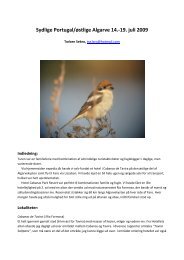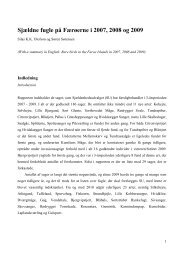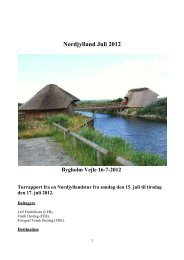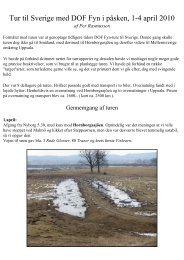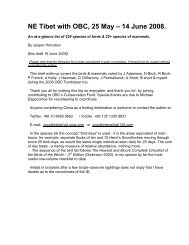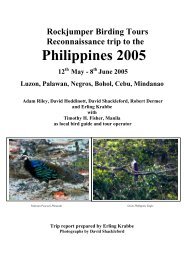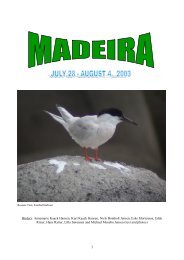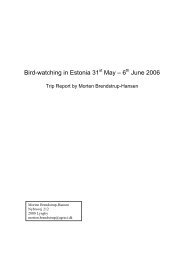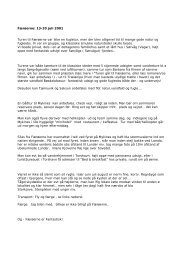TURKEY - a report from a birdwatching trip to Central ... - Netfugl.dk
TURKEY - a report from a birdwatching trip to Central ... - Netfugl.dk
TURKEY - a report from a birdwatching trip to Central ... - Netfugl.dk
Create successful ePaper yourself
Turn your PDF publications into a flip-book with our unique Google optimized e-Paper software.
Erzerum. After 9 km. a sigh leads <strong>to</strong>wards Diyar and Kars. Drive 8.6 km. <strong>to</strong> Halikisla village, then<br />
further 4.4 km. <strong>from</strong> the northern Halikisla sign.<br />
Reported Demirkazik May 2005, but circumstances unknown (Lars and Henrik Rask pers. comm.).<br />
Im autumn small groups gathers, and up <strong>to</strong> 40 have been seen at Lake Van.<br />
Similar <strong>to</strong> Or<strong>to</strong>lan Bunting, but the eye-ring is white, head has a cold bluish-grey tinge lacking any<br />
olive or greenish, the throat and malar are whitish-yellow and the grey breast-bar of Or<strong>to</strong>lan<br />
Bunting lacks. In males, underparts more reddish-brown than the orange-tinged of Or<strong>to</strong>lan Bunting,<br />
often often appears "wooly" (clean-looking in Or<strong>to</strong>lan). The upperparts are cold greyish-brown with<br />
much finer and fainter streaking than in Or<strong>to</strong>lan, the lower scapulars are reddish brown, in good<br />
contrast <strong>to</strong> rest of upperparts (clean and uniformly well streaked in Or<strong>to</strong>lan) and the tertials fainter<br />
patterned (see e.g. Mullarney et al. 1999) with more even, but diffuser edges and brownish-tinged<br />
centres.<br />
The species is patchily distributed between SE Turkey and <strong>Central</strong> Asia. Winters Pakistan and W<br />
part of India. In Turkey represented by ssp. cerrutii (Turkey, Iran), which is the palest ssp. The<br />
nominate form (N Afghanistan <strong>to</strong> W Pakistan) darker with more brownish-grey, less olive-tinged<br />
mantle, less contrasting scapulars and paler, less extensive reddish underparts; belly often paler than<br />
breast. Ssp. neobscura (<strong>Central</strong> Asia <strong>to</strong> W China) similar <strong>to</strong> mominate, but darker with greyer<br />
crown and olive-tinged mantle (Byers et. al 1995). Some birds in winter (ssp. unknown) may show<br />
very slight yellow tinge <strong>to</strong> eye-ring (U. Gjøl Sørensen & Jugal Tiwari per e-mail).<br />
The song is harsher than in Or<strong>to</strong>lan Bunting, lacking the full, melancholic <strong>to</strong>ne, but often more<br />
varied and with third <strong>to</strong>ne being the strongest. The call is a short "stip" similar <strong>to</strong> Creszschmar´s<br />
Bunting.<br />
295. Cinereous Bunting Emberiza cineracea Gulgrå Værling<br />
2005: 22.5 1 male semenowi Isikli - 22.5 15 Durnalik (of which at least 2 male cineracea; the rest<br />
semenowa).<br />
2006: 24.5 35 Nemrut Dagi (all semenowa).<br />
2007: 23.5 5 Karadut – 23.5 30 Nemrut Dagi – 24.5 1 Hotel Euphrates, Karadut – 24.5 3 Karadut –<br />
24.5 65 Nemrut Dagi (all semenowa).<br />
Local breeder in dry, s<strong>to</strong>ny slopes with patches of macchia, scattered trees and open plantations.<br />
Turkish population estimated <strong>to</strong> between 500 and 5000 pairs (Byers et al. 1995). In Turkey,<br />
cineracea is regarded as solely breeding in the W part of the country. The population is well<br />
seperated <strong>from</strong> the restricted range of semenowi, which breeds in areas between Adana and Birezik<br />
(mainly noted in Durnalik/Isikli area and Nemrut Dagi) north <strong>to</strong> at least Nemrud Dagi (the famous<br />
archeaological site near Adiyaman), where common around and especially above tree-limit in dry,<br />
bushy hills, especially along the road leading <strong>to</strong> the acheolological site (Occhiati 2001, Hendriks<br />
2004, see also Red-tailed Wheatear), but also along the gravel road <strong>to</strong> the opposite site of the site,<br />
leading <strong>to</strong> Arsemeia. Also regular at Halfeti. Frequently noted south of Van Gölü.<br />
Male Cineracea has lime-yellow restricted <strong>to</strong> throat, malar and face, with grey hindneck <strong>to</strong><br />
upperparts (showing faint greyish-brown streaks), grey breast and flanks and paler whitish belly.<br />
Male semenowi has lime-yellow throat, malar and underbody with the grey of breast of flanks being<br />
slighly yellowish-tined. Often head appears olive-yellow on<strong>to</strong> hindneck. Upperparts otherwise as<br />
cineracea, but streaking sometimes slightly warmer tinged brown (pho<strong>to</strong>es, skins, Byers 1995.).<br />
The song was noted as a 5-<strong>to</strong>ned "tjy – TJY-VY (vy) - tse-li", with the last part higher-pitched than<br />
the first two parts, albeit with some variation. It had a hoarse <strong>to</strong>ne.<br />
At Durnalik, two cineracea were observed in 2005 (occurence in the area of both ssp. has also been<br />
noted by Schwalbe 2001), but serenowi dominates here, and was the only ssp. observed at Nemrut<br />
Dagi. One serenowi-looking bird at Durnalik in May 2005 showed clear contrasting grey hindneck




